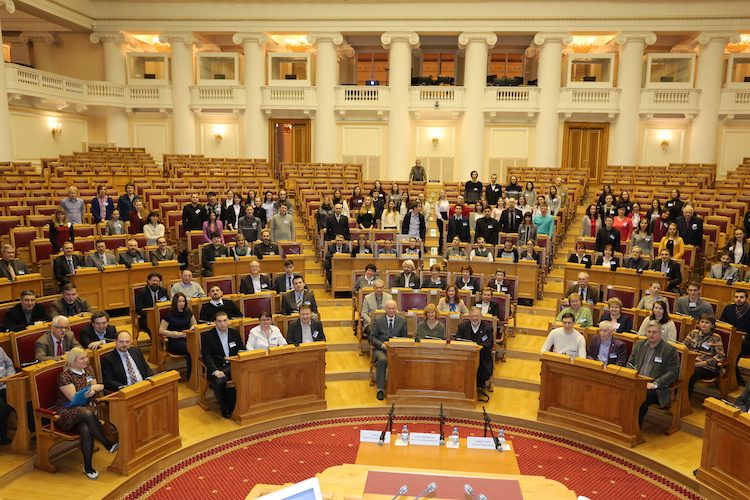On December 8 and 9, 2016, the Tauride Palace in St. Petersburg hosted the 10th annual Tauride Readings, an international academic conference on parliamentary history. Among the presenters at the forum was IMR Senior Advisor Vladimir Kara-Murza.

Participants of the 2016 Tauride Readings in the old Duma Chamber at the Tauride Palace.
The Tauride Readings, a conference on Russian and world parliamentary history, have been held annually since 2007 under the auspices of the Center for the History of Parliamentarianism. As in previous years, the 2016 Tauride Readings were held at the Tauride Palace in St. Petersburg—the seat of the Russian State Duma between 1906 and 1917, and the site of the first and only meeting of the Russian Constituent Assembly in January 1918. Since 1992, the Tauride Palace has served as the headquarters of the Inter-Parliamentary Assembly of the Commonwealth of Independent States.
This year, more than ninety historians participated in the Tauride Readings. Among them were leading experts in the field of Russian parliamentary history, including Professor Andrei Nikolayev (Herzen State Pedagogical University in St. Petersburg;) Dr. Kirill Solovyev (Institute of Russian History at the Russian Academy of Sciences;) Dr. Igor Kiryanov (Perm State University;) Professor Rustem Tsiunchuk (Kazan Federal University;) Dr. Vadim Demin (Institute of Russian History at the Russian Academy of Sciences;) and Professor David Raskin (St. Petersburg State University.) The conference was chaired by Lidia Krokhina, director of the Center for the History of Parliamentarianism.
The Center for the History of Parliamentarianism will publish an anthology, which will include Kara-Murza’s article, “B.Y. Nemtsov as a Russian parliamentarian.”
The two-day forum featured roundtables and seminars devoted to various aspects of parliamentary history, including the conduct of elections in Russia in the early 20th century; the functioning of the First State Duma; attempts to form a parliamentary government in 1906; the Duma’s role in the February Revolution of 1917; parliamentary reform in Great Britain in the second half of the 19th century; the powers of Congress in the early years of the United States; the emergence of modern Russian parliamentarianism in the 1990s; as well as the biographies of various Russian parliamentarians in the early and late 20th century.
Among the participants of the 2016 Tauride Readings was IMR Senior Advisor Vladimir Kara-Murza, who presented a paper on the work of Boris Nemtsov in the Russian parliament in the 1990s and 2000s. “Boris Nemtsov is well known as the first governor of the Nizhny Novgorod region, as deputy prime minister of Russia in the 1990s, and as one of the leaders of the Russian opposition in the 2000s,” Kara-Murza noted. “His parliamentary activities have not been studied as well. Yet for thirteen years he worked in Russia’s highest legislative bodies: as a people’s deputy of the RSFSR; as a member of the Supreme Soviet’s legislative committee; as a member of the Federation Council and of the State Duma.”
Following the 2016 Tauride Readings, the Center for the History of Parliamentarianism will publish an anthology on parliamentary history, which will include Vladimir Kara-Murza’s article, “B.Y. Nemtsov as a Russian parliamentarian. Congresses of People’s Deputies, Supreme Soviet, Federation Council, State Duma. 1990–2003.”

